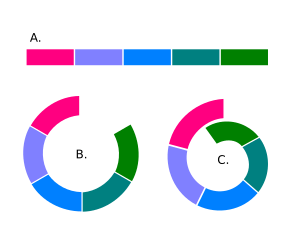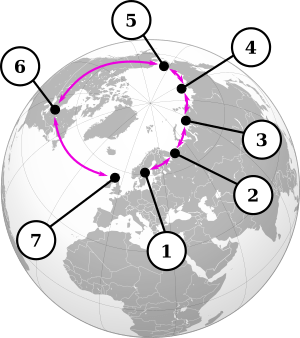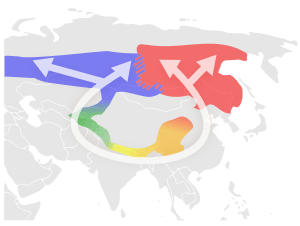Speciation facts for kids
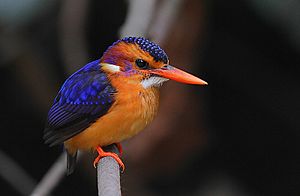
Speciation is the process of how new species (types of living things) are formed. It's a big part of how evolution works.
Long ago, Charles Darwin thought most new species came from old ones simply by changing over time. This is called anagenesis. But now, scientists think most new species appear when an old species splits into two or more new ones. This is called cladogenesis.
Usually, new species form because something stops groups of the same species from breeding with each other. These are called isolating mechanisms.
Contents
Isolating Mechanisms: How Species Become Different
Isolating mechanisms are things that stop groups within a species from successfully breeding together. This creates reproductive isolation, meaning they can't have offspring that can also have babies. This idea is key to the biological species concept, which says that species are groups that can't breed with other groups.
We can split these isolating mechanisms into two main types: those that happen before breeding and those that happen after.
Before Breeding: Stopping Mating
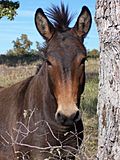
These are things that stop individuals from even trying to mate.
- Geographic isolation: Groups live in different places, often separated by barriers like mountains or oceans.
- Temporal isolation: Individuals don't mate because they are active at different times. This could be different times of day or different seasons. Their mating times just don't match up.
- Ecological isolation: Individuals only mate in their favorite habitat. They don't meet others from different habitats.
- Behavioral isolation: Individuals from different groups might meet, but they don't recognize each other's mating signals. They usually choose to mate with their own kind.
- Mechanical isolation: Mating might be tried, but the bodies of the individuals don't fit together. This could be due to size or shape differences.
- Gametic incompatibility: Sperm is transferred, but it can't fertilize the egg.
After Breeding: Stopping Success
These factors stop mating from being successful, even if it happens. This includes problems with genetics, or if the mixed offspring (called hybrids) can't survive or have babies.
- Zygotic mortality: The egg is fertilized, but the very first cell (the zygote) doesn't grow.
- Hybrid inviability: A hybrid embryo starts to form, but it doesn't survive.
- Hybrid sterility: The hybrid offspring survives and grows up, but it can't have its own babies. A mule (horse + donkey) is a good example.
- Hybrid breakdown: The first generation of hybrids can have babies, but their grandchildren or later generations can't survive or have babies.
Geographical Isolation: Speciation by Distance
This is thought to be the most common way new species form. The idea was first suggested by Moritz Wagner, a German natural historian.
Wagner studied flightless beetles in Algeria. He noticed that different but closely related species of beetles lived on different stretches of the coast. Each stretch was separated by rivers flowing from the Atlas Mountains to the Mediterranean Sea. As soon as you crossed a river, a new beetle species appeared.
Wagner believed that a new species would only form when a few individuals moved away from their main group and stayed separated for a long time. This idea was later brought back by Ernst Mayr and became a key part of how we understand evolution.
Another name for geographical speciation is allopatric speciation. "Allopatry" means "different land."
Vacant Islands: New Homes, New Species
Volcanic islands start with no life. All living things have to arrive there by wind or water. We know from places like the Hawaiian Islands and the Galápagos Islands that life forms change a lot when they reach these islands from the mainland.
The Hawaiian Islands have the most different kinds of fruit flies in the world. There are about 800 known Hawaiian fruit fly species! Studies show that species tend to move from older islands to newer ones.
Scientists believe all native Hawaiian fruit fly species came from one single ancestor that arrived about 20 million years ago. Because there wasn't much competition and lots of empty niches (roles in the environment), this single species quickly evolved into many different ones.
Ring Species: Evolution in a Circle
A ring species is a chain of groups that live next to each other. Each group can breed with its neighbors. But, the two ends of the chain overlap, and these two end groups are too different to breed with each other.
Ring species are great examples of evolution happening. They show how groups change over time and become different species. Richard Dawkins said they show us in space what usually happens over time.
It's hard to find a perfect example, but here are some good ones:
Larus Gulls: A Ring Around the Pole
A famous example is the Larus gulls, which form a ring around the North Pole. Generally, these gulls can breed with their neighbors. But, where the two ends of the ring meet in Europe, the Lesser black-backed gulls and Herring gulls are too different to breed.
Ensatina Salamanders: A Horseshoe of Life
The Ensatina salamander is a ring species found in the mountains around California's Central Valley. They form a horseshoe shape. While each of the 19 groups around the horseshoe can breed with its neighbors, the groups at the two ends of the horseshoe cannot breed with each other.
The Greenish Warbler: Around the Himalayas
The Greenish Warbler (Phylloscopus trochiloides) also shows a ring pattern. Different types of these birds spread east and west around the Tibetan Plateau. When they met again on the northern side, they were too different to breed.
Sympatric Speciation: New Species in the Same Place
Sympatric speciation is when two or more new species form from one original species, even though they live in the exact same place.
This often happens with insects that start to depend on different host plants in the same area. However, whether sympatric speciation truly happens is still debated by scientists. Some argue that these examples are actually very small-scale geographical speciation. One of the most accepted examples is the cichlid fish in Lake Nabugabo in East Africa, which might be due to sexual selection (when individuals choose mates based on certain traits).
Speciation by Polyploidy: Extra Chromosomes
Sometimes, new species can form very quickly through something called polyploidy. This is when an organism ends up with more sets of chromosomes than usual. For example, if a plant with four sets of chromosomes mates with one that has two sets, their offspring might have three sets and be unable to have babies. This immediately creates a new, separate group.
Many plants and some animals have become polyploid during their evolution.
Hawthorn Fly: A Modern Example
One example of evolution happening now is the hawthorn fly, Rhagoletis pomonella. It seems to be undergoing sympatric speciation.
Different groups of hawthorn flies feed on different fruits. In North America, a new group of flies appeared in the 1800s after apples were brought to the area. This new group only eats apples, not the hawthorn fruit that their ancestors preferred. The original hawthorn-feeding flies still mostly eat hawthorns.
There is evidence that these two groups are becoming separate species. Apple flies mature earlier than hawthorn flies, and they don't breed much with each other (only about 4-6% of them mix). This shows how a new species can start to form right before our eyes.
Hybridization: Mixing Species
Rarely, a new species can form when individuals from different species mate. Usually, the offspring of these mixed matings (called hybrids) can't have babies, or they are not as strong, so natural selection removes them.
However, one new and successful hybrid species has been found: a mix of the Italian and Spanish sparrows. Scientists checked this using DNA from their blood. This new bird lives in Italy, in the same area as both parent species, but it doesn't breed with the Spanish sparrow, even though they live side-by-side.
Artificial Speciation: Humans Helping New Species Form
Humans have also helped create new species through breeding, like in domestic animal husbandry. For example, domestic sheep were created by mixing different types of wild sheep. Now, domestic sheep can't have babies with one of the wild species they came from.
On the other hand, domestic cattle can still breed with several types of wild ox and have fertile offspring. This means they are still considered the same species.
Lab Species: Creating New Species in Experiments
The best examples of new species being created in a lab happened in the late 1980s. Scientists William Rice and G.W. Salt bred fruit flies (Drosophila melanogaster) using a maze. The maze had different habitats, like light/dark and wet/dry.
After 35 generations, the two groups of flies that preferred different habitats became reproductively isolated. This means they only mated within their preferred areas and would not mate with flies from other areas.
Another scientist, Diane Dodd, also showed how reproductive isolation can happen in Drosophila pseudoobscura after only eight generations. She used different food types (starch and maltose) to create different groups of flies that preferred one food over the other, leading to them only mating with flies that liked the same food.
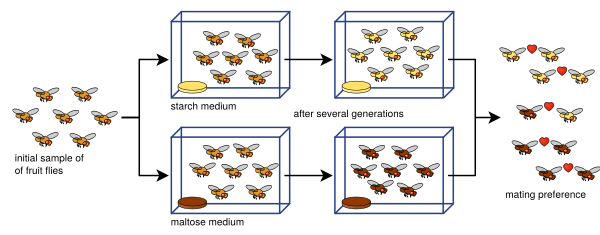 Dodd's experiment has been easy for other scientists to repeat, even with different types of fruit flies and foods.
Dodd's experiment has been easy for other scientists to repeat, even with different types of fruit flies and foods.
Reinforcement (Wallace Effect): Making Isolation Stronger
Reinforcement is when natural selection makes reproductive isolation stronger.
This can happen if two groups of the same species are separated for a while and then come back into contact. If they are already completely reproductively isolated, they are already two separate species.
But if their isolation is not complete, they might still breed and produce hybrids. If these hybrids can't have babies, or if they are weaker than their parents, then natural selection will favor parents who choose to mate only with their own group. This stops the groups from mixing and helps them become completely separate species. This idea is sometimes called the Wallace effect, named after Alfred Russel Wallace.
If the hybrid offspring are stronger than their parents, then the two groups will just merge back into one species where they meet.
Reinforcement is important when there's a "hybrid zone" where two different groups of a species meet and breed. Without reinforcement, these groups would keep mixing, and they wouldn't become separate species.
Images for kids
-
Cichlid fish like Haplochromis nyererei became many different species through sympatric speciation in the Rift Valley lakes.
See also
 In Spanish: Especiación para niños
In Spanish: Especiación para niños


